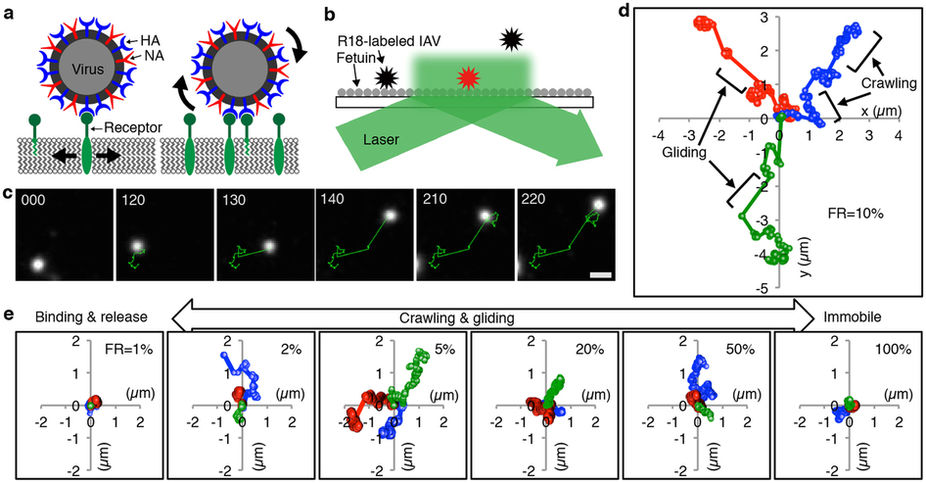A型インフルエンザウイルスのヘマグルチニンとノイラミニダーゼは新しい運動装置として機能する
Influenza A virus hemagglutinin and neuraminidase act as novel motile machinery
2017年3月27日 Scientific Reports 7 : 45043 doi: 10.1038/srep45043

A型インフルエンザウイルス(IAV)の膜タンパク質であるヘマグルチニン(HA)とノイラミニダーゼ(NA)は、ウイルスの感染性、伝播性、病原性、宿主特異性、主要な抗原性の決定要因である。HAは、宿主細胞上のウイルス受容体(シアロ糖タンパク質あるいはシアロ糖脂質)に結合して、宿主細胞表面へのウイルスの吸着を仲介する。加水分解酵素であるNAは、ウイルス受容体からシアル酸を切断し、宿主細胞からの子孫ウイルスの放出を促進する。本研究では、HAとNAがウイルスの運動装置であるという新しい機能を突き止めた。HAは、結合相手の受容体を繰り返し交換することで、細胞表面を模した人工表面、受容体をコートしたガラスの表面、でウイルスを運動させた。このウイルス運動はNAにも依存していた。さらに,HAとNAによって仲介されるウイルス運動により、培養細胞へのウイルスの侵入が3~4倍上昇した。我々は、HAとNAの協調により細胞表面上でIAV粒子が動くことで、宿主細胞へのウイルス感染を高めていると結論する。
Corresponding Author
Influenza A virus (IAV) membrane proteins hemagglutinin (HA) and neuraminidase (NA) are determinants of virus infectivity, transmissibility, pathogenicity, host specificity, and major antigenicity. HA binds to a virus receptor, a sialoglycoprotein or sialoglycolipid, on the host cell and mediates virus attachment to the cell surface. The hydrolytic enzyme NA cleaves sialic acid from viral receptors and accelerates the release of progeny virus from host cells. In this study, we identified a novel function of HA and NA as machinery for viral motility. HAs exchanged binding partner receptors iteratively, generating virus movement on a receptor-coated glass surface instead of a cell surface. The virus movement was also dependent on NA. Virus movement mediated by HA and NA resulted in a three to four-fold increase in virus internalisation by cultured cells. We concluded that cooperation of HA and NA moves IAV particles on a cell surface and enhances virus infection of host cells.

